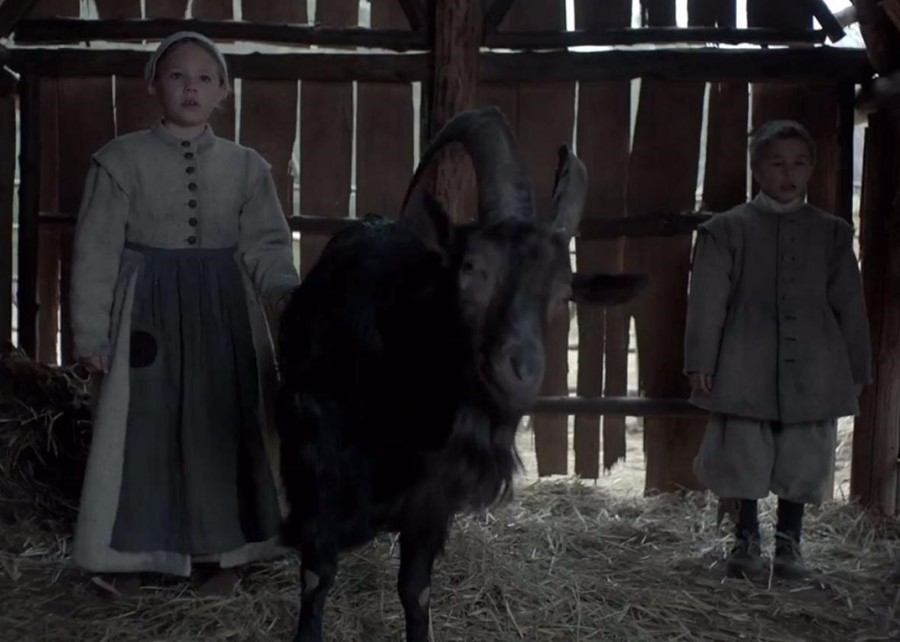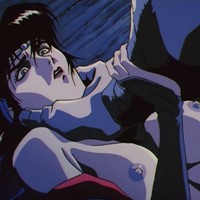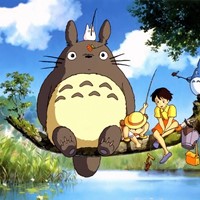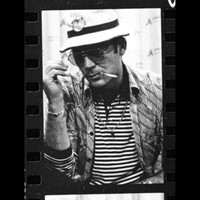We speak to director Robert Eggers on the making of a 17th-century horror classic
Famously, when Werner Herzog looks into the eyes of a chicken, he sees evil. For me, goats have always held a sinister fascination, so naturally when the first trailer for The Witch, Robert Eggers’ diabolical “New England folktale”, arrived full of deep religious foreboding and suspicious farmyard animals, I knew I had to go and see it.
What is the goat’s role in all of this? You’ll have to watch to find out, but suffice to say first-time director Eggers makes brilliantly unsettling use of a range of animals’ peepers – goats, hares and ravens alike – to imply a lurking evil that stalks a family of New England settlers as they set about trying to tame the great American wilderness. Having parted ways with their colony, the pilgrims have only the belief in a New Eden to still the hunger in their bellies, but the seeds of disquiet are sown when the youngest of the brood is snatched away into the woods, apparently by a wolf. Then, as things go from bad to worse, the family begins to fear the devil is in their midst – and no one from the kids to the farm’s resident goat is safe from suspicion.
For The Witch itself, the devil lies in the details. Eggers, a New England native, gives the film a stunning, painterly feel, and is especially good at suggesting the virgin forest – where our titular witch may or may not dwell – as a kind of vast Rorschach blot upon which the settlers project their deepest, darkest fears. Then there’s the thrill of the period dialogue (“Must I hear the devil wag his tongue in thy head?”), bits of which were lifted wholesale from historical documents discovered during the director’s research.
But for all its attention to historical detail and careful character development – pious parents William and Katherine make for a surprisingly likeable pair of religious zealots – The Witch takes a resolutely mythical approach to its subject matter. Neither a Crucible-esque railing against historical injustice nor a trashy exploitation of the above, Eggers’ film instead explores the witch as an archetype buried deep in the collective unconscious. Which makes it the rare witchcraft-related horror film it’s OK for feminists to enjoy.
We got in touch with the director to hear the devil wag his tongue in his head.

What gave you the idea to make The Witch?
Robert Eggers: Growing up in New England, the area’s past is very much a part of my consciousness. It’s hard not to feel that way. The woods behind my house seemed haunted, haunted with witches, puritans, pilgrims and things. So I wanted to make a kind of New England nightmare from the past, like an inherited puritan nightmare, something that would hopefully reawaken primal and ancestral fears within us.
You delved into historical accounts of witchcraft while researching your film, was there anything that surprised you particularly?
Robert Eggers: Pretty much everything that surprised me during my research made its way into the story. I mean, definitely there were anecdotes that didn’t make it in – there was something about a doll that came to life down by a river, which was very interesting, and there’s lots of talk the ‘witch’s mark’, you know, which were extra nipples that witches would have or extra bits on their bodies or their genitals.
You show the witch pretty early on in the film, which in horror terms is usually a bit of a no-no, why is that?
Robert Eggers: I show the witch to the audience right away, which isn’t to say the witch is real or not. But the audience doesn’t know what a 17th century witch is, (so I had to let them) know what she is capable of, and to see what the stakes are straight away.
Did you ever think of keeping the witch out of it completely? To suggest that maybe all of this was happening in the characters’ heads?
Robert Eggers: It was very important for the witch to be there for me, definitely there were conversations about taking her out in various stages of the edit, but I like my witch!
There are other moments in the film where you seem to be playing with horror movie convention, like the scene where Caleb seems to be possessed. Was that intentional?
Robert Eggers: I think (I made certain choices) not so much to go against the grain of horror movies, but because 98 per cent of the supernatural stuff needs to be approached in a way that could be real, or scientifically explained so the audiences can believe it. For me, I can see a possession scene (in another movie), with all its cheesy hullaballoo, and I can see its artifice everywhere, I’m not invested. But (in my film) there’s nothing that Caleb does that he couldn’t do, even if he wasn’t possessed.
The Witch is a pretty arty film that seems to have found a mainstream audience, which I think has thrown a lot of people who were maybe expecting something else...
Robert Eggers: Yeah it’s really cool for a lot of teenagers, this is the first arty movie they’ve seen and they’re really excited by it, but there’s a lot of people who are furious, who feel like they were lied to by the marketing campaign and they hate this movie, they couldn’t hate it more. I am certainly sorry they feel that way, but this kind of conversation is very interesting.
Some critics have taken exception to the fact that, even though the film is presented with a high degree of historical realism, the witch is revealed to be ‘real’. Like you’re betraying the historical fact of witch trials by caving into the demands of the horror genre, somehow.
Robert Eggers: I think that is a fine accusation and I respect people who feel that way, generally the good reviews are by reviewers who have understood my intentions. It doesn’t mean that the other people didn’t get it, it just means that my kind of storytelling doesn’t work for them, or I wasn’t able to articulate my in intentions in a way that works for them. That’s cool, but I think just because I show the witch doesn’t mean that she is real, there are plenty of people that think the witch is in their head. I’m not saying that that’s the way it is, but there are multiple interpretations. I have my own answers to all the questions, but I deliberately try to keep things open-ended, and if that is having my cake and eating it too, I’m guilty!
On the other hand, some people have called it a feminist film...
Robert Eggers: That is my intention, I’m not trying to judge religion or condemn it, or any of that stuff. I really care about this family and what they feel, I really love them. It’s painful to see them fall apart and their struggles in trying to do the right thing, even though they are part of a worldview that destroying their own daughter. It’s complicated.
I was struck by how much I liked the characters in your film, despite their religious convictions.
Robert Eggers: There’s real love story there, they’re human beings. It’s wrong to think of people being as (purely being) silly and superstitious, people are always complicated. Even right now, I’m focused on medieval knights, and the armour that was made was so sophisticated, (although) it was made with basic tools. There are certain things about medieval armour that we can’t replicate because we don’t have the skills, (even) with the technology they had they were masters. People are people, they’re complex and interesting, they love and they feel.
Why did you decide to give the family in the film Yorkshire accents?
Robert Eggers: Well, it’s a long story. The family were originally going to be from Essex, because a lot of the puritans that came over were from Essex. But Ralph (Ineson, who plays William) was the first person we cast and he’s from Yorkshire, and I really liked his accent. I did a little research and the oldest timber framed house in Massachusetts was made by a Yorkshire man who came over in 1630 or so, and didn’t get along with all these Essex folks and moved his family away.
The film has a very painterly feel to it, were there any specific artists or paintings that influenced the film?
Robert Eggers: I am really into art history and I really do like Rembrandt and these things, but my director of photography Jarin Blaschke and I weren’t trying to replicate old paintings, we were just trying to use natural light, sculpt it so well. When you put someone in 17th century clothing next to a side-lit window, it’s going to look that a Dutch golden age painting. It’s just going to happen.
But apparently there’s a visual nod to a Goya painting in there?
Robert Eggers: That’s definitely true.
There are also quite a few fairytale references in the film, right? Sleeping Beauty and especially Hansel and Gretel sprang to mind at various points...
Robert Eggers: I actually did a short film of Hansel and Gretel, which is a pile of trash that cannot ever be seen by human eyes. But you’ve got to start somewhere!
There also seems to be a connection implied between the encroaching sexual maturity of the eldest daughter, Thomasin, and the failure of the land to produce crops, which is interesting, because witch trials are often linked to periods of famine historically speaking...
Robert Eggers: Yeah, if you read it’s not hard to find the history, it’s right there in front of you. If your crops were dying, your animals were sick or your child died, you know, it could be a witch. I’m very interested in this time in New England, when western culture over here was so primitive that it was the Middle Ages for a brief time in North America. Very experienced English farmers were coming here and didn’t know what to do because the land they’d been working in England had been cultivated for generations, and it didn’t work over here. And there were wolves and all kinds of things, it was rough. The English puritans had a strange relationship with nature, on the one hand America was like a new Eden for them, a new Jerusalem, and on the other hand the devil was in all of nature. It was complicated.




